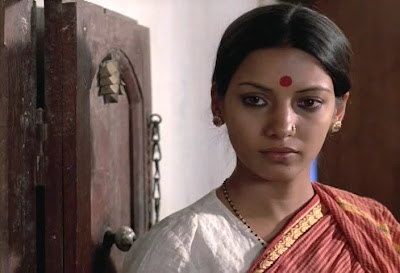
Nishant
Original Screenplay : Vijay Tendulkar
Year : 1975
Run time :140 minutes
Hindi with English sub titles
6th July 2008 ; 5.45 pm
Ashwin Hospital Auditorium
Contemporary Indian filmmake Shyam Benegal’s second film, NIshant (1975)explores the corrupt world of landowners and local bureaucracy in

Shyam Benegal has a well-deserved reputation for making hard hitting social dramas which tell true Indian stories in a realistic manner. He seems to be ever pre-occupied in supporting the forces which are taking
 Shabana gives a rangy and volatile performance There is a certain raw tension in Nishant, an anticipatory mood that is compelling even when nothing is happening. Shyam Benegal's dusty, dusky visuals, along with many silent or near-silent scenes, seem to enhance the tension with their spareness. And it is a great treat to see so many giants of parallel cinema displayed in their unpolished youth - Shabana, Smita, Naseer, Kulbushan, and Mohan Agashe and Anant Nag (as the zamindar's other two brothers) are all fresh out of school; none of them had more than two films' experience prior to Nishant, and even Amrish Puri had only played half a dozen roles.
Shabana gives a rangy and volatile performance There is a certain raw tension in Nishant, an anticipatory mood that is compelling even when nothing is happening. Shyam Benegal's dusty, dusky visuals, along with many silent or near-silent scenes, seem to enhance the tension with their spareness. And it is a great treat to see so many giants of parallel cinema displayed in their unpolished youth - Shabana, Smita, Naseer, Kulbushan, and Mohan Agashe and Anant Nag (as the zamindar's other two brothers) are all fresh out of school; none of them had more than two films' experience prior to Nishant, and even Amrish Puri had only played half a dozen roles. 
The film won the 1977 National Film Award for Best Feature Film in Hindi, and was invited to Cannes Film Festival, the London Film Festival 1976, Melbourne Film Festival 1977, and the Chicago Film Festival 1977, where it was awarded Golden Plaque.
(Thanks to Film Geek http://www.filmigeek.net/2006/10/nishant.html )

Shyam Benegal

Contemporary Indian filmmaker Shyam Benegal has been an important figure in the new wave of Indian directors. Benegal originated what has come to be called "middle cinema". He was initially involved in the advertising industry and produced over 900 advertisements before his interest turned to films.
As a young man, he went on to found a film society and get involved in acting while studying at
In 1969 he received a special fellowship to study operations of the Children's Television Workshop in
Since then he has become a popular director in
His film directorial debut was Gher Betha Ganga in 1962. Benegal shot to fame with Ankur 1973, which introduced Shabana Azmi, who also starred in Nishant 1975. The success that New India Cinema enjoyed in the 1970s and early 1980s could largely be attributed to Shyam Benegal's quartet Ankur (1973), Nishant (1975), Manthan (1976) and Bhumika (1977), which were artistically superior yet commercially viable films. Tapping fresh talent mainly from the FTII and NSD, Benegal has made several sensitive and stimulating films.
He was awarded the Padma Shri in 1976 and the Padma Bhushan in 1991. On 8th August 2007, he was awarded the highest award in Indian cinema for lifetime achievement, the Dadasaheb Phalke Award for the year 2005. He is only director to have won the National Film Award for Best Feature Film in Hindi five times.














